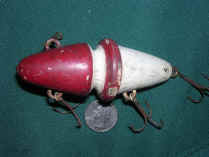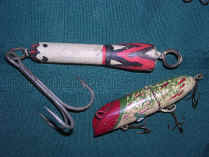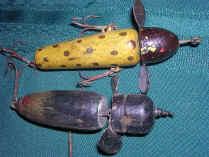The homemade wooden minnow to the right came from Michigan and has a
line tie on each end, and a paint job that resembles the early Trory and
Pardee Minnow lures. The mouse below has a braided tail made from
fishing line - and metal ears. One of my favorite folk art lures is the
egg-shaped creation (BELOW RIGHT) with the grooves and the early square
box swivel. I suspect his one might date to the late 1800s.
|
 |


|
 |
The
large rotary head (RIGHT) has been suspected to be a Hagen Impeller from
Wisconsin, but others say it is a homemade antique lure. The reverse
pecker-head (BELOW CENTER) looks a little like a Jim Donaly bait - but
it came from Michigan. The colorful lures (BELOW RIGHT) hail from
Chicago and closely resemble the Jim Dandy baits - right down to the
twisted wire hook protectors.
|
 |
 
|
 |
Fly
rod anglers also created their own brand of folk
art fishing lures. The wooden bass bugs (RIGHT) are
well-made and old, and the white one may be a Walter Wilson bug, made in
Shelbyville, Ind. The red lure with white hair (BELOW LEFT) has a body
cased in leather. The colorful wobbler (BELOW CENTER) was built using
Moonlight Bait Co. hardware. The quadruple spinner (BELOW RIGHT) is a
mystery. It originated in upstate New York and has a cork body hand
wrapped onto to the shaft. Its four bladed prop is painted red on one
side and luminous on the other.
|
 |


|
 |
The
big tarpon bait (RIGHT) was found in south Florida. The rotary head
lures shown below are interesting, but quite typical of homemade wooden
lures from the 20s and 30s. The trio of colorful folk art lures (BELOW
CENTER) came from Chicago and the banana-shaped one is very well
machined. The two wooden minnows (BELOW RIGHT) resemble a Heddon
Artistic Minnow and Bucktail Surface Bait. Both have belly weights and
marked Heddon props. |
 |
|
  |
 |
|
The mouse and water sonic bait
(RIGHT) resemble Creek Chub products, including the Jigger. The
green-gray mouse (BELOW CENTER) is a folk art lure made to copy the
Shakespeare Pad-Ler. The Peckerhead bait (BELOW RIGHT) has wonderful
patina and early, long-shanked Bing's treble hooks. These folk art lures
likely date to the 1920s or 1930s. |
 |
 
|
 |
The
early handmade lure (RIGHT) includes an external belly weight, which
could date this piece to the pre-1910 years. The shaft going through the
lure beside it is reminiscent of a FLying Helgramite, but we likely will
never know the maker. The leather-tail minnow (BELOW LEFT) came from New
York and is half-decoy and half lure. Other baits (BELOW RIGHT) are made
from a clothespin, and from glass lamp beads.
|
 |
 
|
 |
The plump lure at top of photo has a diving lip that resembles a Creek
Chub product, but the lip is fashioned from an old metal can. The belly
hardware is a Neverfail hook hanger made by Pflueger. The lower lure is
crudely made and painted, but the precise placement of its two belly
weights makes it likely that it was built to catch fish. Folk art lures
are almost always hand carved wooden baits. |
 |